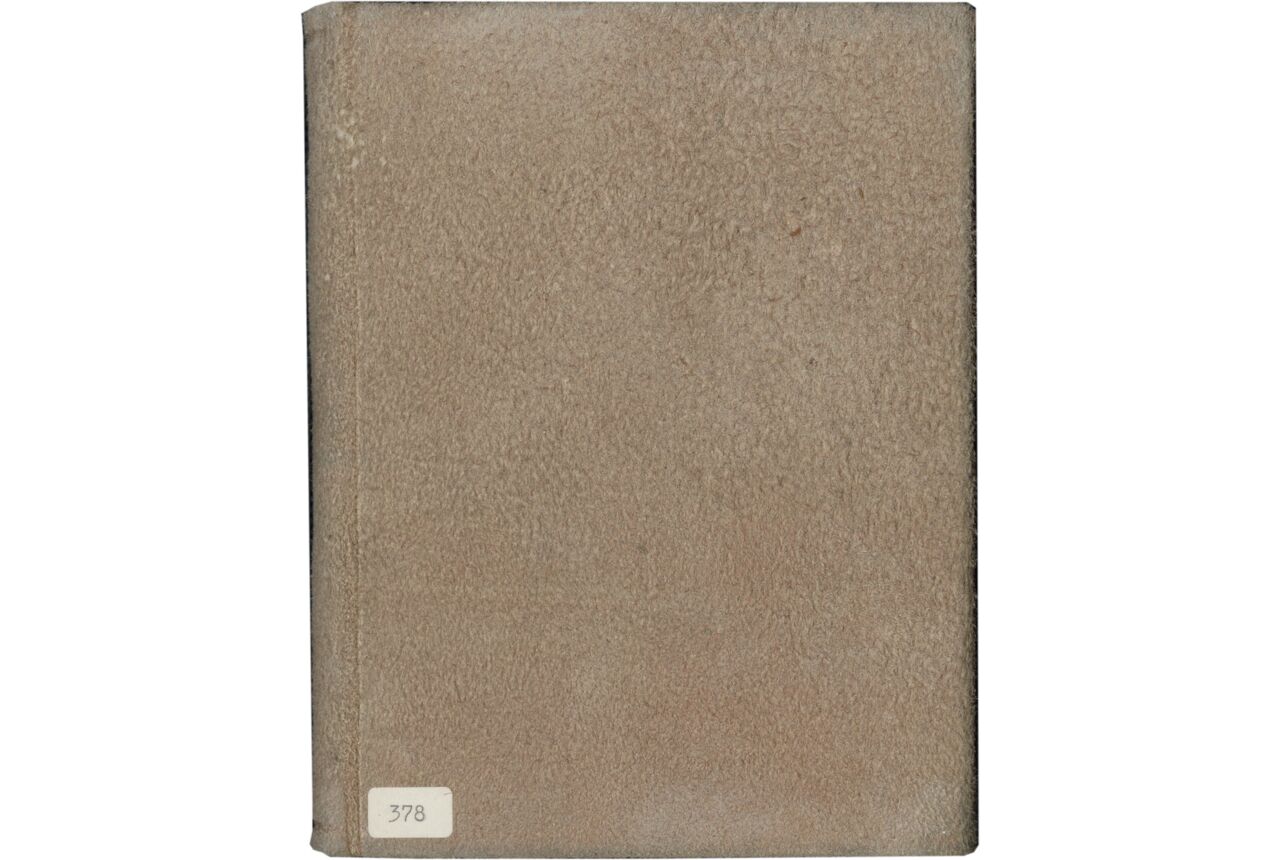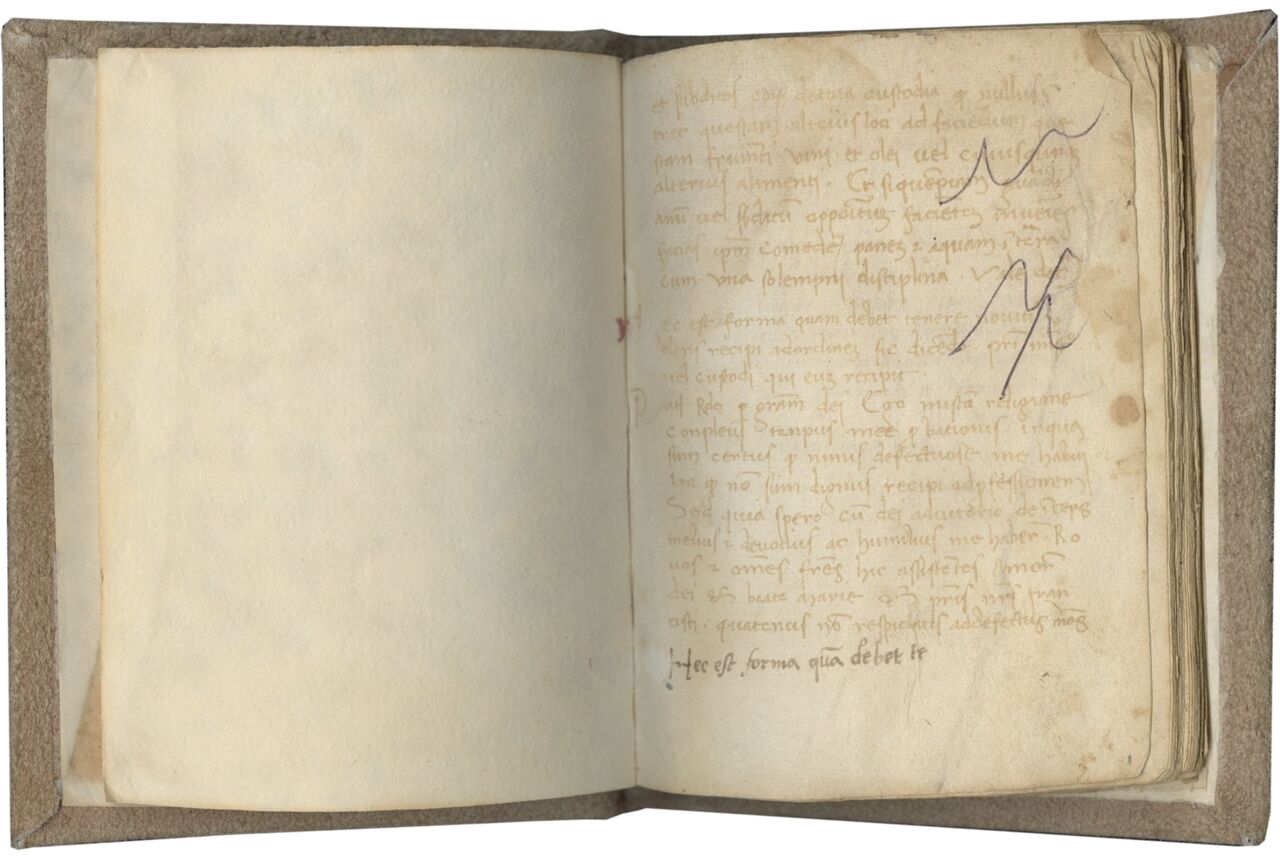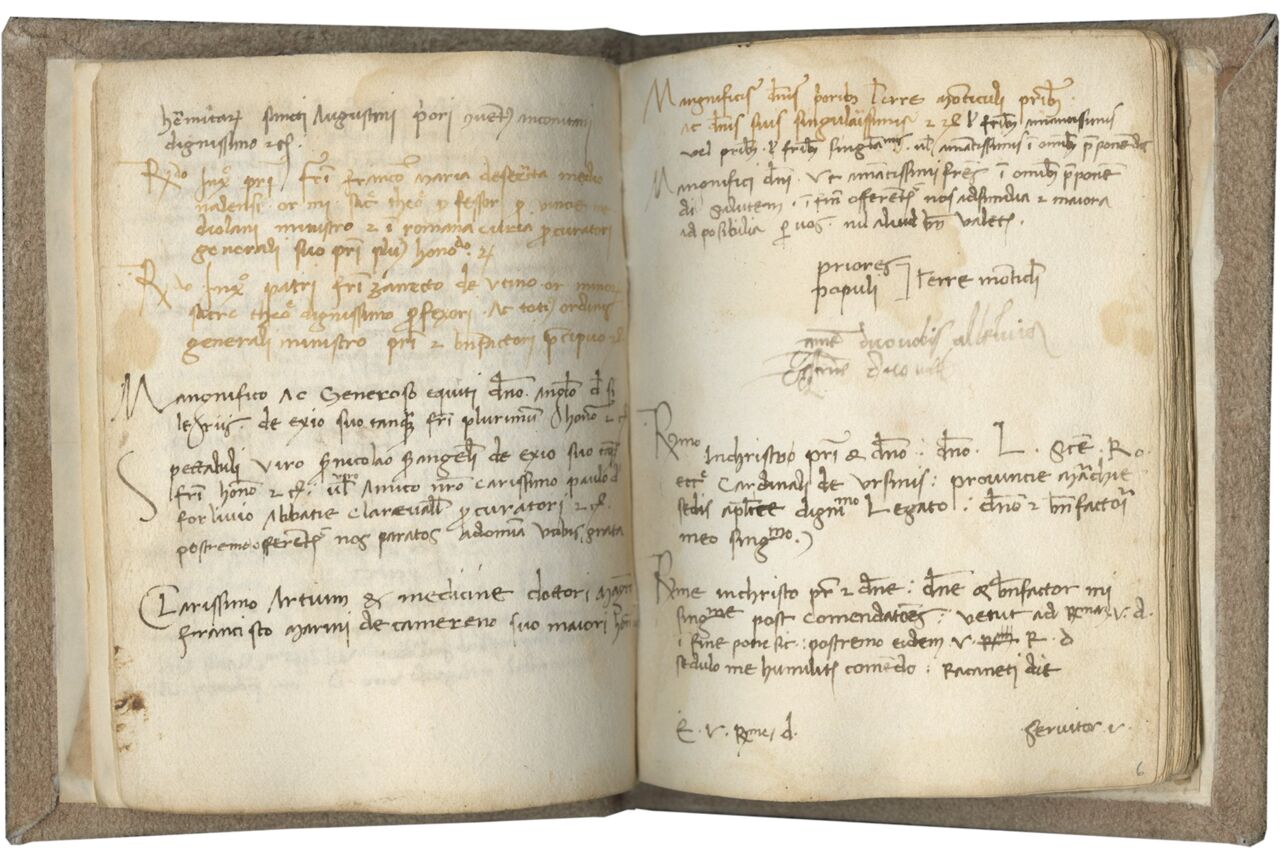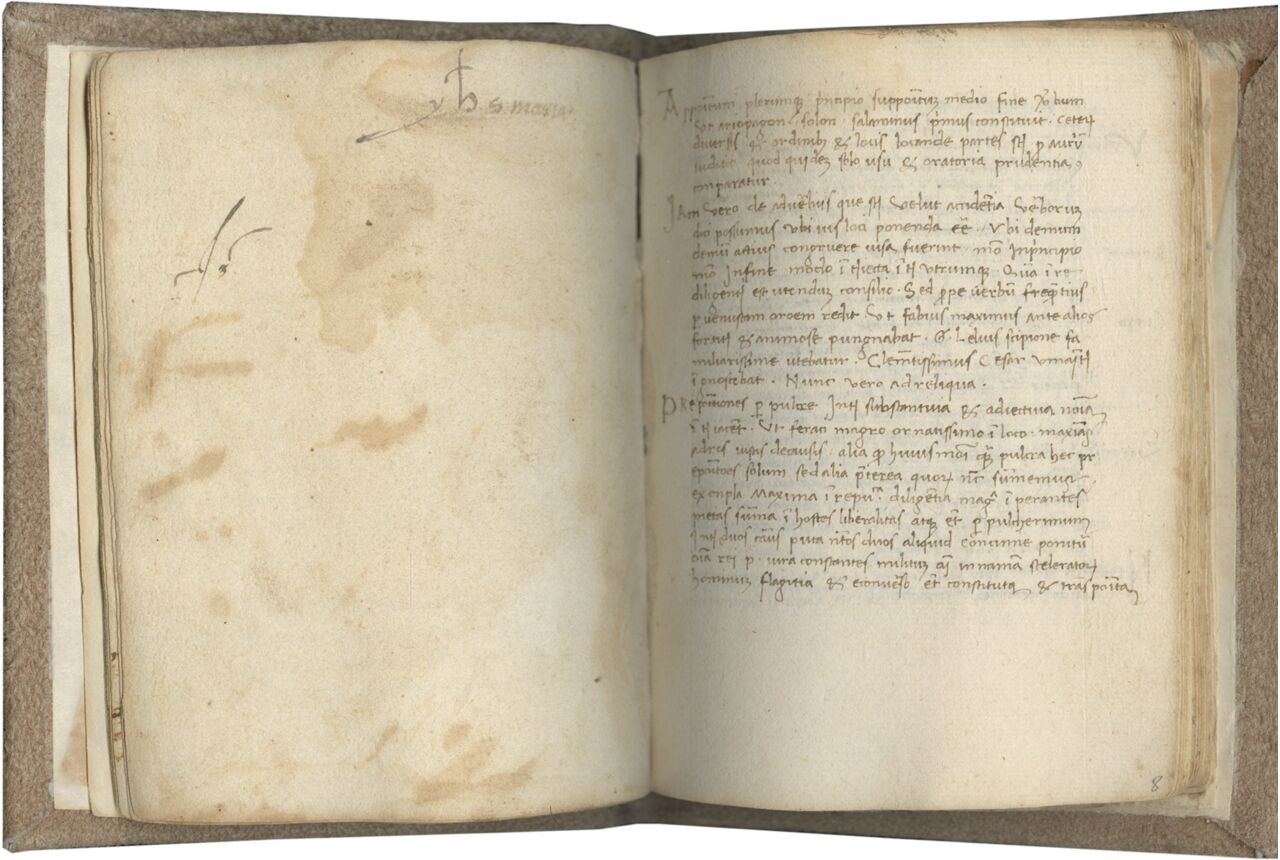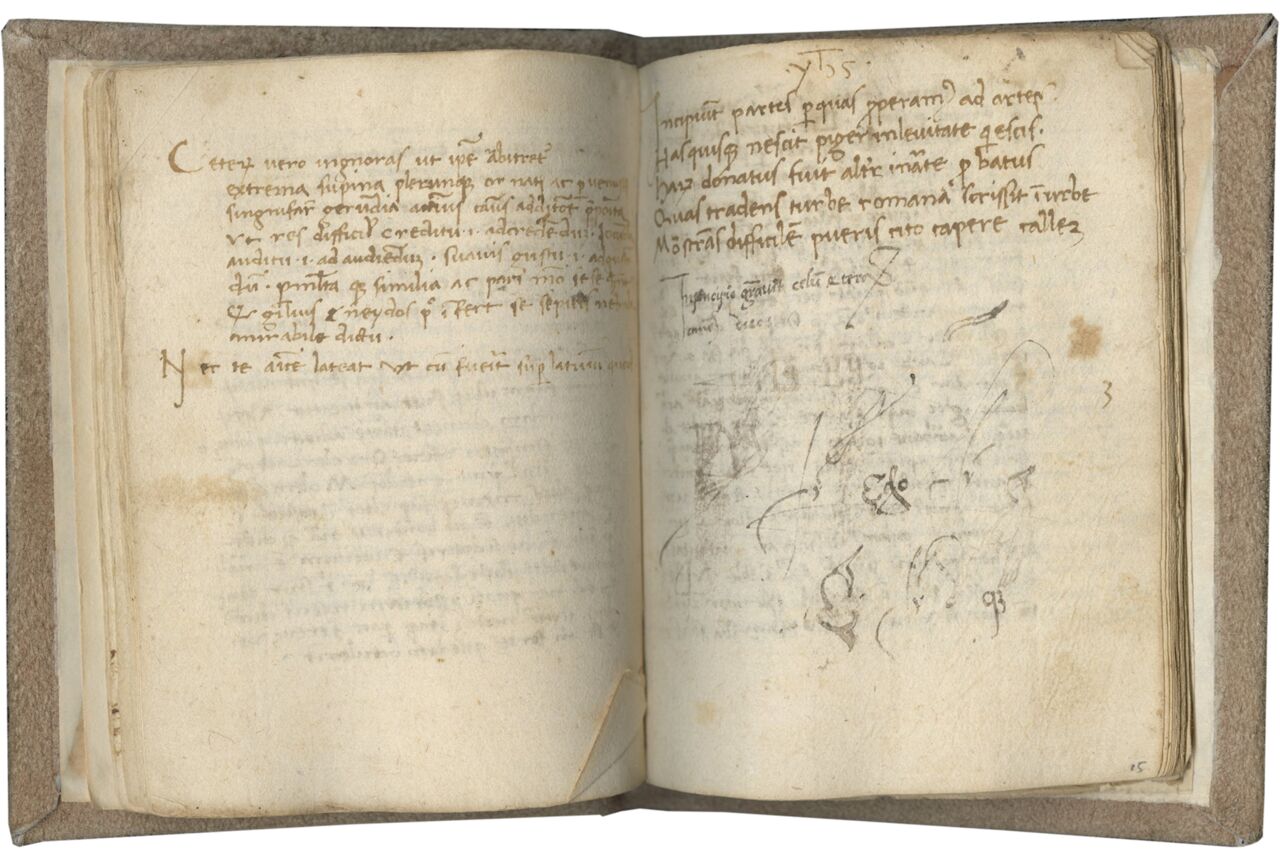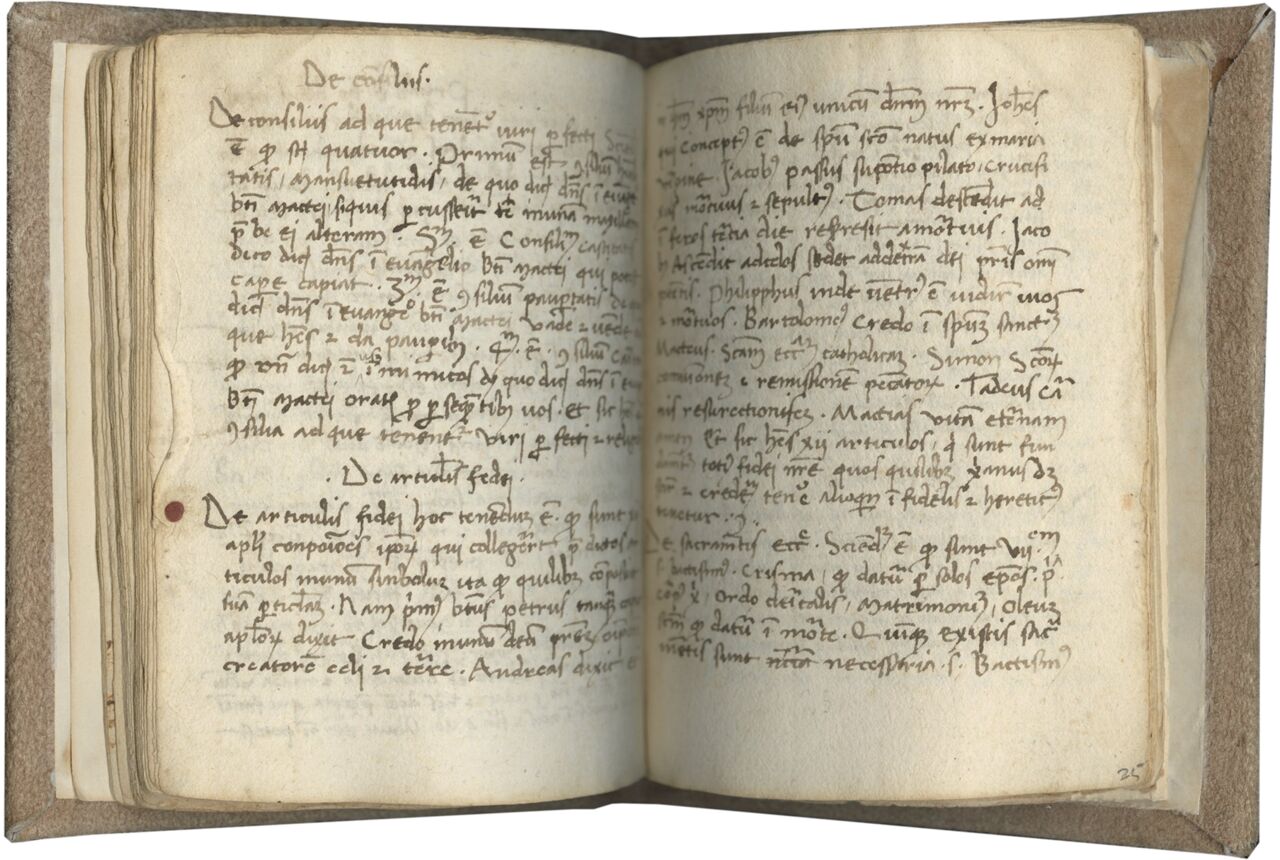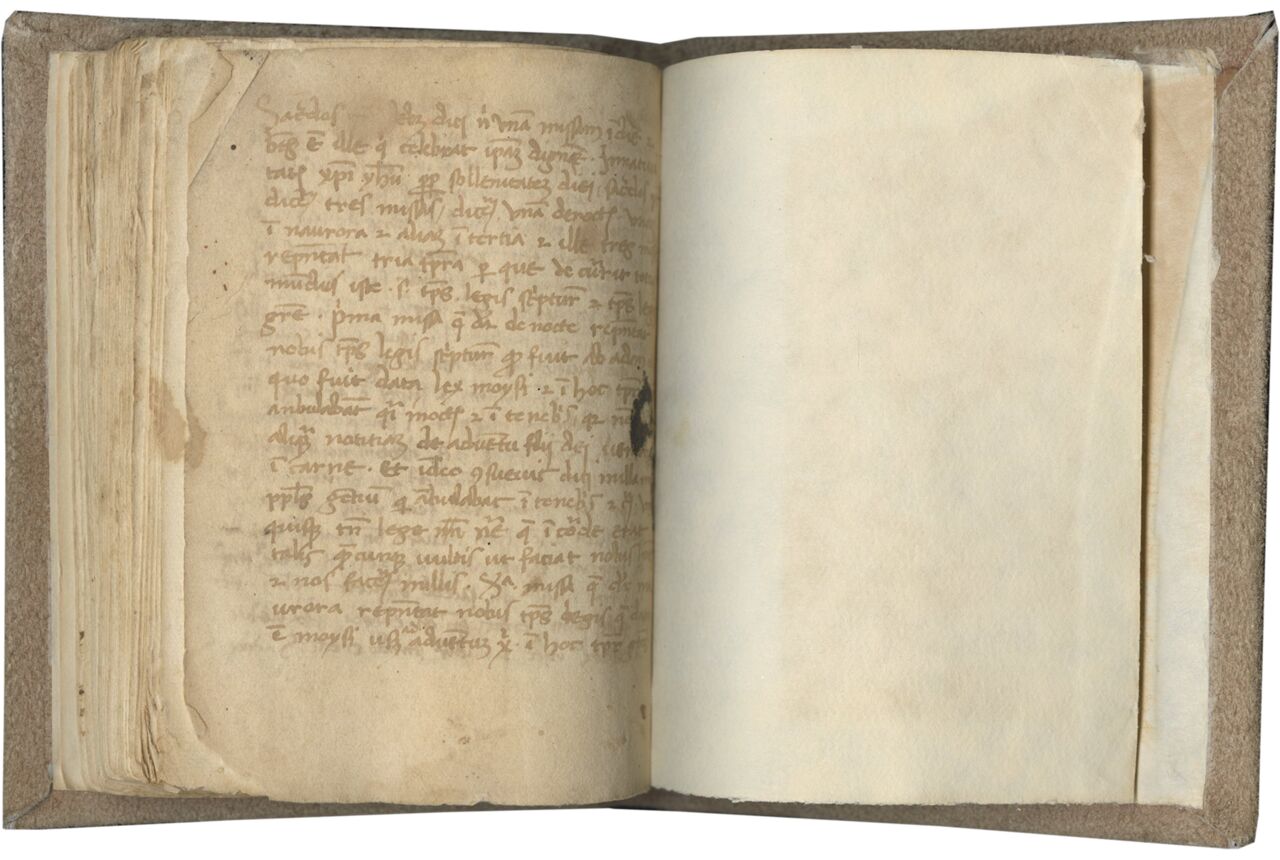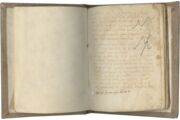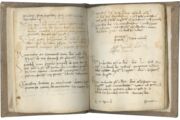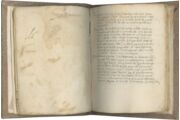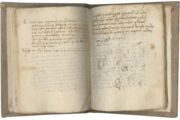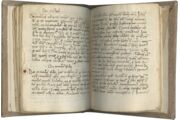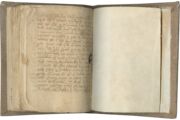i (paper) + 40 + i (paper) folios on paper, traces of watermarks at ff. 5, 6, 8, 9 (and perhaps at ff. 20, 21, 28, 32, 33), that at f. 8 possibly part of a coat of arms, no hits in Briquet and Piccard, modern foliation in pencil, in Arabic numerals, lower fore-edge recto, 1-40, two leaves torn out with loss of text between f. 30 and f. 31) leaving triangular stubs (collation i6 ii-iv8 v12 [-1 and 2, before f. 31, with loss of text, stubs remain]), no catchwords or signatures, occasional faint blind ruling (e.g., f. 11), ff. 31-37 ruled in brown ink (justification Part I, ff. 1-6, 97-112 x 79-85 mm.; Part II, ff.8v-14v, 92-97 x 75-78 mm.; Part III, ff. 15v-40v, 99-119 x 74-85 mm.), no pricking, written above top line in a series of humanistic cursive hands (ff. 1-3v, 3v-6, 8-13v, 13v-14v, 15-40v) varying in register, all likely by the same scribe, in multiple shades of brown ink, Part I in 19-26 lines, Part II in 20-25 lines, Part III in 19-26 lines, section titles given in plain ink, each centered on its own line, occasional enlarged initials in plain ink, scribal corrections via subpunct (e.g., f. 11, line 11) or marginal insertions (e.g., f. 16), scribbles with a modern pen in purplish-black on f. 1, water damage in Part I, some stains and dog-eared edges throughout, loss of text after f. 30v (extend unclear, though 2 stubs remain), fading ink at ff. 1-3v, overall in good condition. Modern (twentieth-century) binding in napped, greyish beige fabric over boards, minor stains on rear cover, in good condition. Dimensions c. 145 x c.105 mm.
A pocket-sized, highly personalized collection of texts, this miscellany offers precious insight into the intellectual interests of a Franciscan friar in fifteenth-century Italy. Perhaps our friar was still a novice, because of the mix of secular and religious texts (both doctrinal and liturgical). The process of producing this miscellany was an active one, both in terms of the choice of texts and their presentation. Few of the texts were simply mechanically copied, but instead are presented in original, heavily abridged forms.
Provenance
1. Copied in Italy in the last quarter of the fifteenth century, based on paleographical and textual evidence. A reference to Pope Sixtus IV at f. 2v indicates that the manuscript’s opening section must have been written after 1471 (the start of his papacy).
2. Pen-trials and annotations in fifteenth- or sixteenth-century hands, in black or brown ink, at ff. 1, 7v, 12v, 15-15v, 30v.
3. Twentieth-century rectangular sticker, 9 × 15 mm., in white, labelled “378” in a sans serif font, in black ink (affixed to outer front cover at lower left corner).
4. Modern (20th- or 21st-century) bookseller or owner annotations, in pencil, “MS 84,” circled (inner front cover), and “MLC 378” (first flyleaf, recto).
5. Purchased from Bernard Rosenthal, 1986-1987, by Marvin L. Colker (1927-2020), becoming Colker MS 378; the Rosenthal receipt, dated April 20, 1987, described the codex as “MS 84 Miscellanea, sm. 8vo. Italy, c15” (unverified; reported in previous description). Not included in Bond and Faye’s summary of Colker’s collection (1962, pp. 516-517). Colker was Professor of Classics at the University of Virginia and a renowned paleographer, who catalogued the manuscripts at Trinity College Library, Dublin, and who assembled an impressive collection of medieval material.
Text
ff. 1-5, incipit, “//et subditos eorum de tota custodia quam nullus intret questam alicius [sic] loci ad faciendum questam frumenti vini et olei uel … hospites etiam in locis ubi ultra tres dies moram contraxerint in dicant in capitulo culpas suas et dicta culpa et accepta penitentia egrediantur. deo gratias amen”;
Anonymous short notes and excerpts from Franciscan statutes and ordinances including, at f. 1rv (“Hec est forma quam debet tenere noviti volens recipi ad ordinem … promitto tibi vitam eternam. Dando sibi osculum pacis.”), a text similar, but not identical to “Ad visitatorem monasteriorum Tuscie, de forma visitandi,” part of the 1263 Rule of the Poor Clares; edited, Horowski, 2017, pp. 142-145; and, at f. 5, an excerpt from the 4th rubric of the Constitutions of Friars Minor from the 1260 General Chapter at Narbonne (“Cum informa interius conversandi 4° c° [capitulario] constitutionum generalium scriptum sit. Item nullus frater a culparum capitulo eximatur. hospites etiam in locis ubi ultra tres dies moram contraxerint in dicant in capitulo culpas suas et dicta culpa et accepta penitentia egrediantur. deo gratias amen.”); edited, Denifle and Ehrle, 1892, pp. 87-138, at p. 99. For the remainder of the excerpts, no edition is known.
ff. 5-6, incipit, “In dei nomine Amen. Quando scribitur alicui clerico minori in principio lictera sic dicitur. Dilecte in Christo frater uel dilecte amicus …; In suprascriptione dicatur. Honestissimo viro domino .N. …; Si esset lector idem guardianus vel custos vel prior. Venerabili et Religioso viro fratri .p. ordinis minorum francisci …; Reverendissime in christo pater et domine: domine et benefactor …”; [ff. 6v-7v, blank];
Anonymous examples of forms of address clearly written for use in a Franciscan milieu; no edition known. Rather than designating specific individuals, the provided names – including Paolo da Forli, Francesco Marini da Camerino, Cardinal Orsini – were likely intended to elucidate addressing persons of particular ranks.
ff. 8-14v, incipit, “Appositum plerumque principio suppositum medio fine verbum ut ariopagon | solon | salaminus primus constituit … Nec te amice lateat ut cum fuerit superlatiuum quod”;
Agostino Dati, Elegantiolae (alt. Isagogicus libellus), starts and ends imperf.; edited, Warner, 2012. Starting and ending imperfectly, our copy corresponds to p. 80, line 6 through p. 112, line 1, of Warner’s 2012 edition (where the edition proper runs pp. 76-235). While Warner’s edition lacks section headers, our witness covers approximately paragraphs 3-23. Our witness shows numerous deviations from the latter text, including variations in orthography and syntax, plus lacunae and additions.
f. 15, incipit, “Incipiunt partes per quas properamus ad artes … Monstrans difficilem pueris cito capere callem”;
Anonymous, untitled five-line verse, in rime leonine; edited, Black, 2001, p. 53, n. 118. Also attested in Florence, Biblioteca Medicea Laurenziana, MS Strozzi 80.
ff. 15v-30v, incipit, “De beatissima trinitatis quoniam in unitatis substantia est trinitas personarum. De trinitate dei hoc tenedum est … michi non fecistis. Item in suplicium eternum. Iusti uero in vitam eternam”;
Giles of Rome, Capitula fidei christianae ad Tartarum maiorem, cc. 1-9, 11-20, abridged; cc. 1-9, followed by c. 11 with c. 10’s rubric (c. 10 itself lacking), then cc. 12-20, with a catchword at bas-de-page f. 30v supplying the next chapter’s rubric (“De inferno”). The chapter itself, however, is missing; our codex lacks cc. 21-27. Two roughly torn stubs after f. 30 reveal missing leaves, but how much of Giles’ work our scribe originally copied remains unclear. Edited, Venice, 1593 (USTC 828057).
f. 31-31v, incipit, “[Cr]ucifige eum. Item in tali hora emisert spiritum sanctum in die pentecostem. Item /<Christus?>\ <hēlmus?> ipsum in sexta hora laudare quia in tali hora ligno Crucis affissus est Christus … intercedat pro nobis et facit nos recipi in eterna tabernacula ubi completum est gaudium electorum. Amen”;
An abbreviated excerpt from Guillaume Durand, Rationale divinorum officiorum, book 5, c. 1 (“De Divinis Officiis tam nocturnis, quam diurnis in genere”), s. 8, here beginning imperfectly; edited, Durand, 1775, pp. 192-193.
ff. 31-32v, incipit, “De officio septuagesime et tempore septuagesime repentat illud tempus in quo filii ysrael steterunt in captivitatis in babillonia pro septuaginta annos … opera domini doramus et cetera. non dicitur gloria patris adororem et laudem eternitatis”;
Anonymous, De officio et tempore septuagesime; no edition known. Otherwise unidentified theological treatise discussing the origin and significance of the divine office for Septuagesima, the liturgical period immediately before Lent. The Babylonian Captivity referenced at the start is said to have lasted for seventy years (the Latin septuagesima denotes ‘seventy’) and the Septuagesima begins on the ninth Sunday – approximately seventy days – before Easter (when counting days in a specific way). Also attested in Les Enluminures, TM 770, ff. B 17v-21v , a Franciscan miscellany described on this site.
ff. 32v-34v, incipit, “De officio lamentationum quod fit per tres noctes pascha resurrectionis domini. Sciendum est quod pro illas tres noctes repentamus … in aurora representat nobis tempus dlegis que data est moysi usque / ad \ adventus Christi in hoc tempore gentes.”
Nicolaus Andreae, De officio lamentationum, abridged; imperfect end; no edition known. This work discussing the Office of Lamentations (read during the Divine Office for the three days prior to Easter) is attested in at least eight other manuscripts: the six listed on Mirabile (s.v., “De officio lamentationum”); plus Gießen, Universitätsbibliothek, Hs 854, ff. 180-190v; and Wrocław, Uniwersytet Wrocławski, [Theologica], ff. 111-119v. Our copy roughly corresponds to f. 121, line 1 through f. 127, line 7 (i.e., para. 1 to halfway through para. 62) in the Cambridge witness (University Library, MS Add. 5358, ff. 121-137v).
This pocket-sized collection features a range of secular and religious works suitable for a Franciscan friar-in-training – and perhaps compiled by one for personal consultation. Following the opening section (discussed below) it offers an imperfect copy (ff. 8-14v) of a guide to elegant writing and speaking most commonly known as the Elegantiolae sive libellus elegantiarum ad Andream Capaccium by Augustinus Datus Senensis (1420-1478), an orator, preacher, and teacher of rhetoric and philosophy (Lee, 1985, p. 378). This short text was an ideal choice for humanist writers striving to refine their Latin style and for budding catechists learning to persuade. Described as “a kind of Cliffs Notes for sounding like Cicero” (Celenza, 2005, p. 519), the Elegantiolae has occasionally, though inaccurately, been designated a mere epitome (Jensen, 1990, p. 56; 1996, p. 24) or imitation (Bolgar, 1954, pp. 271, 432) of Lorenzo Valla’s (c.1406-1457) Elegantiae linguae Latinae (Black, 2001, p. 360). Originally titled Isagogicus libellus pro conficiendis et epistolis et orationibus (or ad grammaticam, or in eloquentiae praecepta), but printed under a wide range of titles, Dati’s short treatise on Latin style became a runaway bestseller (GW, s.v., “Datus, Augustinus”). Extant in at least seventy-nine manuscripts, it was first printed in 1470 by Ulrich Zell of Cologne (ISTC id00087500) (Black, 2001, p. 359; “Augustinus Datus Senensis,” Bibale-IRHT/CNRS). Ultimately, Dati’s guide to elegant writing would be issued in more than one hundred incunable editions, with forty further editions issued by 1608 (Black, 2001, p. 360).
The bulk of our little codex (ff. 15v-30v) contains selections from a work by Giles of Rome (c.1243/1247-1316), a.k.a. Egidiani / Aegidii Romani, or Aegidius Columna / Colonna, an Augustinian philosopher–theologian best known as the author of perhaps the most popular medieval “mirror of princes,” De regimine principum (c.1277-1280) (Lambertini, 2019). Our manuscript preserves a witness of one of his lesser-discussed compositions, Capitula fidei christianae ad Tartarum maiorem (alt. De conversione Tartarorum). A summary of the basic principles of the Christian faith composed for the benefit of missionaries to the East, it was likely composed during a stay at the Papal Curia, possibly between 1301 and 1303, at the request of Pope Boniface VIII, with whom Giles had a close bond and to whom he had dedicated both De ecclesiastica potestate and Hexameron (Del Punta, Donati, and Luna, 1993). Surviving in at least forty-two manuscripts (Bloomfield, et al., 1979, no. 1466), it was first printed by Rodolphus Loeffs de Driel in Leuven / Louvain, c.1483/85 (note: GW gives 1484/88 (GW, M48917)), in a collection which falsely identified it as Thomas Aquinas’ Breviloquium ([Urdemann, 1483-85], ISTC id00162400, at sigs. F2v-hiijv). A Venetian imprint followed in 1593; printed by Pietro Maria Bertano et fratelli, it remains the standard edition (Bloomfield, et al., 1979, no. 1466; USTC 828057). According to their “Piano Editoriale,” however, Del Punta and Fioravanti intend to publish a critical edition in Opera omnia, volume 4, part 3 (Del Punta and Fioravanti, 1985, vol. 3, part 1, pp. ix-xi at p. xi).
Giles was born in Rome; little else is known of his early life. By early adulthood, having joined the Order of the Augustinian Hermits, he was sent to study at Paris, likely with a different order or under a secular master, the Augustinian friars then lacking a Regent Master. He probably studied under Aquinas from 1269 to 1272, remaining in Paris until at least 1277, after which he returned to Italy where, from 1281 through 1284, he was involved in his Order’s governance, first as vicar to the Prior General, Clement of Osimo, then (from 1292) as Prior General himself. He died in 1316 as Archbishop of Bourges (Lambertini, 2019).
Interspersed around the foregoing is a series of shorter items including excerpts from Franciscan legislation and ordinances (ff. 1-4v); examples of forms of address, again referencing Franciscans often (ff. 5-6); a five-line verse also attested in Florence, Biblioteca Medicea Laurenziana, MS Strozzi 80, where it precedes a copy of Ianua sum rudibus, the main elementary school grammar textbook of high and late medieval Italy (Black, 2001, pp. 44-63, at pp. 43-44); and three short texts on the liturgy: a condensed version of nearly the first half of Nicolaus Andreae’s (fl. 1314-1316) De officio lamentationum (ff. 32v-40v); a heavily abridged snippet (f. 31-31v) of the Rationale divinorum officiorum by canonist and Bishop of Mende, Guillaume Durand (c.1230-1296); and a copy of the anonymous De officio et tempore septuagesime (ff. 31v-32v). This combination of rhetorical, stylistic, and religious resources – including texts on articles of faith and the liturgy – together with the humble nature of their reproduction – on rough paper, in a small format – point to a reference collection compiled for, and undoubtedly by, a would-be preacher and catechist, likely a novice Franciscan. The manuscript’s idiosyncratic abridgements, and mixture of secular and religious works, are sure to spark the curiosity of scholars of late medieval preaching Orders, particularly mendicant education, as well as collectors with an interest in fifteenth-century Italian book production.
Literature
Bloomfield, Morton W., Bertrand-Georges Guyot, Donald R. Howard, and Thyra B. Kabealo. Incipits of Latin Works on the Virtues and Vices, 1100–1500 A.D., Mediaeval Academy of America Publication 88, Cambridge, MA, 1979.
Bolgar, R. The Classical Heritage, Cambridge, 1954.
Bond, W. H., and C. U. Faye. Supplement to the Census of Medieval and Renaissance Manuscripts in the United States and Canada, New York, 1962.
Briggs, Charles F. “Life, Works, and Legacy,” in A Companion to Giles of Rome, edited by Charles F. Briggs and Peter S. Eardley, Brill’s Companions to the Christian Tradition, 71, Leiden, 2016, pp. 6-33.
Bruini, Gerardo. Le opere di Egidio Romano, Florenc, 1936, no. 58, pp. 138-140.
Bruini, Gerardo. “Rari e Inediti Egidiani,” Giornale Critico della Filosofia Italiana 40, 1961, pp. 310-323.
Celenza, Christopher S. “Petrarch, Latin, and Italian Renaissance Latinity,” Journal of Medieval and Early Modern Studies, 35, no. 3, 2005, pp. 509-536.
Denifle, P. Heinrich, O.P., and Franz Ehrle, S.J. Archiv für Literatur- und Kirchen-Geschichte des Mittelalters, vol. 6, Freiburg, 1892.
Durand, Guillaume. Prochiron, vulgo rationale divinorum officiorum …, Madrid, 1775.
Giles of Rome. Aegidii Romani. Opera Omnia, ed. Francesco Del Punta and Gianfranco Fioravanti, Florence, 1985-.
Horowski, Aleksander. “La Legislazione per le Clarisse del 1263: La Regola di Urbano IV, le Lettere di Giovanni Gaetano Orsini e di San Bonaventura,” Collectanea Franciscana, 87, 2017, pp. 65-157.
Jensen, Kristian. Rhetorical Philosophy and Philosophical Grammar: Julius Caesar Scaliger’s Theory of Language, Munich, 1990.
Jensen, Kristian. “Humanist Latin Grammars in Germany and Their Italian Background,” Italia ed Europa nella Linguistica del Rinascimento: Confronti e Relazioni, 2, ed. Mirko Tavoni, Modena, 1996, pp. 11, 23–41.
Lee, Egmont. “Agostino Dati of Siena,” Contemporaries of Erasmus: A Biographical Register of the Renaissance and Reformation, Volume 1: A–E, edited by P. G. Bietenholz and Thomas B. Deutscher, Toronto, 1985, p. 378.
Marston, Thomas E. “Seven New Italian Incunabula,” The Yale University Library Gazette, 54, no. 1 (1979), pp. 15-17.
Romanus, Aegidius. Capitula fidei christianae Aegidii Columnae Romani. Ord. erem. S. August. archiepiscopi Bituricensis sanctae Romanae Ecclesiae cardinalis, theologorum facile principis, Venice, 1593. USTC 828057.
[Urdemann, Heinrich, et al.]. Dialogus inter Hugonem, Catonem, et Oliverium super libertate ecclesiastica, [Louvain: Rodolphus Loeffs de Driel, 1483-85]. ISTC id00162400.
Warner, J. Christopher. “Quick Eloquence in the Late Renaissance: Agostino Dati’s ‘Elegantiolae’,” Humanistica Lovaniensia, 61 (2012), pp. 65-240.
Online Resources
“Aegidius Romanus: Capitula fidei christianae (1296-1316),” Bibale-IRHT/CNRS
https://bibale.irht.cnrs.fr/39108
“Augustinus Datus Senensis: Isagogicus libellus pro conficiendis et epistolis et orationibus (1440-1470),” Bibale-IRHT/CNRS
https://bibale.irht.cnrs.fr/40339
Briquet Online
https://briquet-online.at/
Del Punta, Francesco, S. Donati, and C. Luna. “Egidio, Romano,” Dizionario Biografico degli Italiani, vol. 42 (1993), Treccani
https://www.treccani.it/enciclopedia/egidio-romano_(Dizionario-Biografico)/
Gießen, Universitätsbibliothek, Hs 854 (digital surrogate)
https://digisam.ub.uni-giessen.de/ubg-ihd-fb/content/structure/3629524
GW: Gesamtkatalog der Wiegendrucke
https://www.gesamtkatalogderwiegendrucke.de/
ISTC: International Short-Title Catalogue
https://data.cerl.org/istc/_search
Lambertini, Roberto. “Giles of Rome,” The Stanford Encyclopedia of Philosophy, Winter 2019 edition, ed. Edward N. Zalta
https://plato.stanford.edu/archives/win2019/entries/giles/
Manuscripta.pl: Przewodnik po rękopisach średniowiecznych w zbiorach polskich
https://manuscripta.pl/
“De officio lamentationum,” Mirabile: Archivio digitale della cultura medievale
https://www.mirabileweb.it/title/de-officio-lamentationum-title/186129
Piccard Online
https://www.piccard-online.de/start.php
Schoenberg Database of Manuscripts
https://sdbm.library.upenn.edu/
USTC: Universal Short Title Catalogue
https://ustc.ac.uk/search
Wrocław, Uniwersytet Wrocławski, [Theologica] (digital surrogate)
https://www.bibliotekacyfrowa.pl/dlibra/publication/144957/edition/135337/
TM 1295


